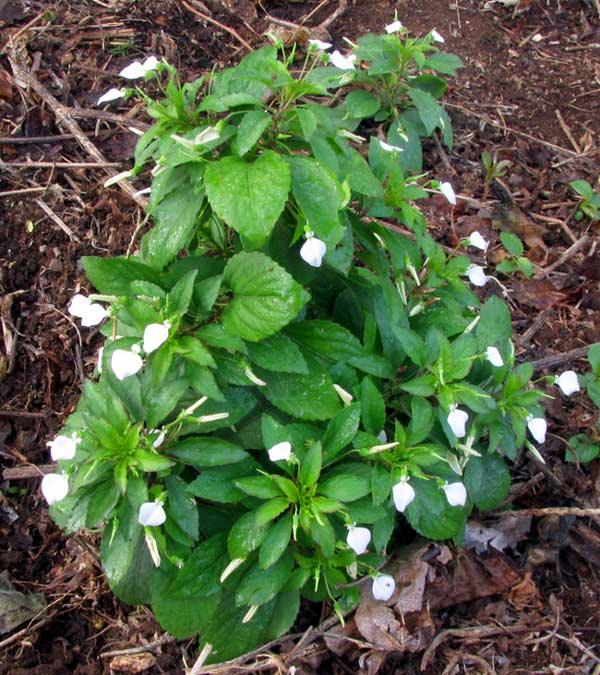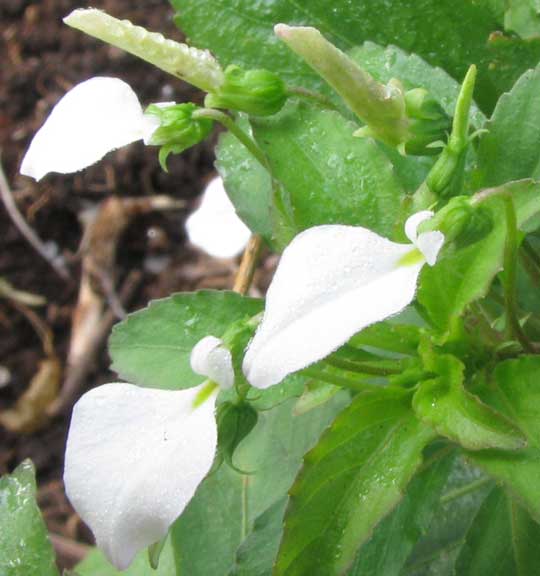Excerpts from Jim Conrad's
Naturalist Newsletter

from the August 15, 2010 Newsletter issued from Hacienda Chichen Resort beside Chichén Itzá Ruins, central Yucatán, MÉXICO; limestone bedrock, elevation ~39m (~128ft), ~N18.52°, ~W95.15°
HYBANTHUS AND THE EVIL EYE
When Luis cleared the understory of the woods near the organic garden, for his milpa, or cornfield, he left the foot-tall, densely leafy, white-flowered herb seen above. I asked him why he'd left it.
"It's medicinal," he said. "For the mal de ojo. It protects babies when drunks or hungry people look at them."
"Mal de ojo is "the evil eye," and we've run into a cure for it before. In this year's May 23rd Newsletter we saw that the woody vine known as Beadvine, Abrus precatorius, serves the same use. That wasn't surprising because the vine produces spherical, red fruits, each bearing a single large, black dot on it, causing the fruit to look like an inflamed eyeball. But this little herb preserved by Luis didn't seem to suggest inflamed eyeballs at all. Maybe the plant works simply by being so pleasing to the eyes, with its dainty, white flowers against such a lush, green backdrop.
The plant belongs to a family known by all North American wildflower fanciers. Can you figure it out? Notice the presence of heart-shaped, shallowly toothed leaves. A closer look at some flowers is shown below:

Notice how the flower at the right terminates a hooked pedicle, and how the green calyx is slightly bisymmetrical, bulging backward at its base. How about the Violet Family?
This is in fact a member of the Violet Family, though not the violet genus Viola. It's HYBANTHUS LONGIPES, in the same genus as the Green-violet found throughout forested eastern North America. The genus Hybanthus holds about 150 mostly tropical and subtropical species, so the North's Green-violet actually is an atypical Hybanthus species because of its frost tolerance. Our Hybanthus longipes is more typical of the whole genus.
The blossom's flaring lower petal is unlike anything seen in northern violets. Also, in violets, that lower petal forms a baglike "spur" extending back and below where the flower attaches to its pedicel. With Hybanthus there's a slight backward bulge but no long spur. Violets are strictly herbaceous, but the wiry stems of our Hybanthus are somewhat woody at their bases. Despite these differences between Northern violets and our Hybanthus, if you break open our plant's half-inch long flower (13 mm) -- most of the length being that big lower petal -- you'll see a floral anatomy very similar to a regular violet flower, especially in how the five stamens join to form a ring around the ovary.
In most woods up north several violet species occur, so for wildflower lovers walking in a springtime woods there's often the pleasure of seeing a number of "variations on the violet theme." At least eight violet species occurred in my little home county in western Kentucky. When you run into this Hybanthus you definitely experience the violet theme, but the variation is so extreme that it's almost a dissonance. But, still, it's a pleasing dissonance.